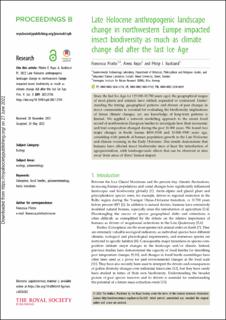Late Holocene anthropogenic landscapechange in northwestern Europe impactedinsect biodiversity as much as climatechange did after the last Ice Age
Peer reviewed, Journal article
Published version

Åpne
Permanent lenke
https://hdl.handle.net/11250/3001307Utgivelsesdato
2022Metadata
Vis full innførselSamlinger
- Publikasjoner fra CRIStin - NINA [2364]
- Scientific publications [1392]
Originalversjon
10.1098/rspb.2021.2734Sammendrag
Since the last Ice Age (ca115 000–11 700 years ago), the geographical rangesof most plants and animals have shifted, expanded or contracted. Under-standing the timing, geographical patterns and drivers of past changes ininsect communities is essential for evaluating the biodiversity implicationsof future climate changes, yet our knowledge of long-term patterns islimited. We applied a network modelling approach to the recent fossilrecord of northwestern European beetles to investigate how their taxonomicand trait composition changed during the past 16 000 years. We found twomajor changes in beetle faunas 4000–3500 and 10 000–9500 years ago,coinciding with periods of human population growth in the Late Holocene and climate warming in the Early Holocene. Our results demonstrate that humans have affected insect biodiversity since at least the introduction of agropastoralism, with landscape-scale effects that can be observed at sites away from areas of direct human impact. Coleoptera, fossil beetles, palaeoentomology,biotic transitions
